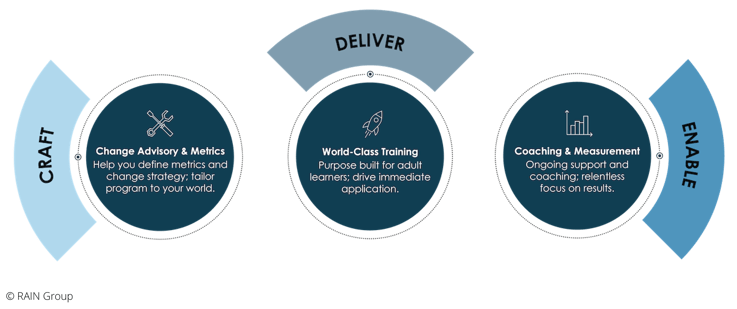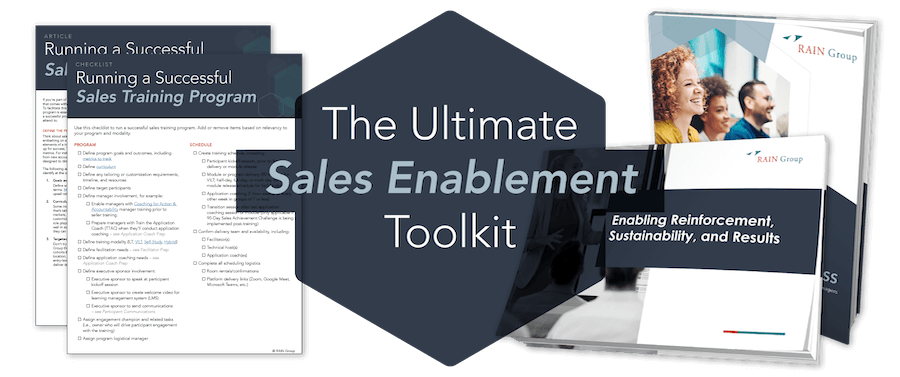In the competitive arena of sales, the true game-changer is having a well-trained sales team whose behaviors result in the desired outcomes.
Consider the case of a technology firm that revamps its sales strategy to focus on consultative selling. During training, a conversation planning tool is shared that helps reps prepare for needs discovery meetings.
The real shift occurs not when the tool is introduced in the program, but when sales reps use the tool on the job and change their approach from product pitching to understanding and addressing the unique needs of each buyer.
It’s this behavioral change that leads to a significant increase in closed sales.
For sales leaders and enablement professionals, the challenge lies not only in evolving their training approaches, but also in fundamentally altering the behaviors and mindsets of their teams to drive real results.
Much like an athletic team striving for a world championship, sales organizations must continuously adapt and elevate their game to succeed.
A recent report from Gartner, Driving Selling Behavior Change, points to two shifts that need to happen for sales organizations to achieve peak performance.
- Focus on changing seller behavior at scale
- Position enablement as strategic partners to chief sales officers (CSOs)
This aligns with what we’ve seen in our research at RAIN Group and our work in the field.
In this article, I’ll highlight key points from the Gartner report and identify how sales organizations can act on these insights.
Gaps in the Current Enablement Approach
Eighty-three percent of CSOs and senior sales leaders report their sellers struggle to adapt to customer needs and expectations, according to Gartner. This suggests that enablement efforts to address seller skills gaps lag business needs.
In addition, because more than half (60%) of sales enablement functions don’t have a formal charter or an annual planning process, their strategic impact is limited. Thus, too many enablement teams end up in a transactional mode, responding to requests by delivering traditional training that focuses on knowledge transfer rather than seller behavior change.
“Enablement leaders need to collaborate with sales leadership to define a new enablement mandate that establishes seller behavior change as the core responsibility of the enablement function.”
-Gartner, Driving Seller Behavior Change
The unfortunate fact is that traditional sales training often fails to change seller behavior. As we’ve previously reported, only 18% of sales organizations rate their training as effective.
The failure could be the result of several infrastructure problems. For example, failure to:
- Define business and learning needs
- Build sales knowledge
- Assess individuals’ skills and capabilities
- Put a sales process and sales methodology in place
- Deliver training that engages
- Reinforce training and make it stick
- Evaluate, hold accountable, and continuously improve
The subsequent lack of seller behavior change may be intentional, but more likely sellers fall back on what they’ve always done when the enablement infrastructure isn’t sufficiently strong.
This disconnect highlights the need for a more strategic approach to sales enablement.
A Model for Changing Seller Behavior
The ultimate objective of enablement goes beyond knowledge transfer. Yes, you want sellers to learn, but you also want them to apply what they’ve learned. The end game is to effectively change seller behavior so desired business results are achieved. This is why RAIN Group advocates for:
- A focus on seller behavior change
- Aligning sales enablement goals with sales strategy
- Measuring the initiative’s impact
A model adapted from the behavior expert BJ Fogg by Gartner provides a formula to explain how people change their behavior:
Behavior Change = Motivation + Ability + Prompt
This means that for someone to change their behavior, three things need to happen:
- Motivation: The person needs to really want to make the change.
- Ability: The person needs to be able to make the change, meaning it's not too hard for them.
- Prompt: The person needs a little push or reminder to do the new behavior.
The idea is that if someone is motivated enough and finds it easy enough to do the new behavior, then when they get a prompt or a nudge, they'll do it. If they're not motivated or find it too hard, even if they're reminded, they probably won't change their behavior.
Motivation and ability can be achieved through tools including training and coaching.
By adding prompts to the equation, and repeating them consistently over time, it’s possible to influence the desired behaviors.
These prompts can be anything that encourages the desired behavior, for example, templates and tools which encourage the implementation of a specific action or process, a sequence of email or text reinforcement messages, time-based execution challenges, and more.
Prompts can also include just-in-time learning.
Imagine a seller who specializes in selling enterprise resource planning (ERP) solutions to large organizations. They have a meeting with a prospect to discuss how their ERP system can improve the prospect’s business processes. Due to a tight schedule, the seller hasn't had the chance to fully customize their presentation for this specific prospect.
Just before the meeting starts, the seller accesses their learning management system through a link in their meeting reminder. They review the sales opportunity planner for the prospect, including details of who will be on the call, current business processes, specific pain points, industry trends, and how their ERP solution can address these needs.
This is an instance of just-in-time learning, providing the seller with prospect-specific information right when it's most needed.
Organizations that implement just-in-time learning strategies for their sales teams are significantly more likely to meet or surpass their sales goals, retain clients, and achieve strong customer satisfaction compared to organizations that don't adopt this method.
According to Gartner, organizations that use just-in-time learning are:
- 2.5x more likely to exceed seller revenue target
- 3.5x more likely to exceed customer retention target
- 2.2x more likely to exceed seller retention target
How to Implement Enablement with a Focus on Behavior Change
You can transform your organization’s sales enablement to focus on behavioral change and align with sales goals by using a framework built on three pillars: Craft, Deliver, and Enable.

1. Craft Training to Drive Results
Start by crafting sales enablement programs specifically to achieve desired business outcomes. This includes aligning training content with sales strategy and tailoring it to participants' specific work context.
This works best when done in collaboration with sales leadership to ensure strategic alignment, shared vision, and support.
During this phase, you answer questions such as:
- Which sales metrics are most likely to drive success?
- What are our organizational goals?
- Which roles will be undergoing training?
- What topics are most relevant for our organization?
- How will training be reinforced?
- How will we monitor progress and results?
For more questions, read What Is Sales Training?
Making the shift to training that drives results will differ based on your answers to those questions. For example:
- A manufacturing company aligns its sales enablement with its strategic goal of entering new markets, focusing on cultural sensitivity and localized selling techniques.
- An insurance firm identifies cross-selling as a key skill gap after assessing their team. They develop targeted training modules to enhance this skill and conduct ongoing application coaching, leading to an increase in average customer policy holdings.
- A pharmaceutical company redefines the sales enablement program by setting clear objectives linked to market penetration and customer engagement. They include role-playing exercises and real-time feedback to drive behavior change.
2. Deliver Experiential Training
Delivering an engaging training experience is accomplished when there’s a mix of modalities, including in-person and virtual instructor-led training, elearning, micro-learning videos, simulations, gamification, tools and templates, and self-study options. These components contribute to learning that’s retained.
Moving away from one-off training events to continuous learning is part of this approach. For example, a technology company relying solely on annual sales seminars finds that its sales team quickly forgets the training content. By shifting to ongoing, interactive online modules, they notice an immediate improvement in product knowledge retention and application.
3. Enable Change
This is where behavior change is either supported or tends to fall apart.
You can enable change by:
- Providing ongoing support and regular coaching to help sellers build action plans and hold them accountable
- Reinforcing training with just-in-time learning prompts and nudges
- Embedding job aids, tools, and available resources in seller workflow
- Sharing successes, wins, stories, and best practices across the team
- Implementing sales challenges and competitions to drive specific behaviors
- Embedding sales enablement in the organization’s culture and linking it directly to sales strategy
- Developing an ongoing development plan
- Measuring, tracking, and reporting on impact and results
The specific actions you take to support behavior change will vary based on industry, organization, team, and goals.
For example, a financial services company uses a mobile app to send daily sales tips and reminders, resulting in a more consistent application of best practices among the sales team.
A software company implements a post-training reinforcement program, including coaching and a 90-day sales challenge, resulting in a marked improvement in long-term skill retention and execution.
These actions foster a culture of continuous learning and improvement, which supports behavior change alignment with business goals.
Getting Started: How Do You Identify Sales Skills and Capabilities Gaps?
Since each seller’s skill set differs, how do you know:
- Which skills and capabilities to develop
- Which behaviors, if changed, will lead to the desired sales results
A well-designed assessment provides an opportunity for sales managers to honestly assess their team’s selling abilities. This, in turn, gives sales leadership and enablement teams the guidance and direction needed to roll out initiatives that will move the needle.
For example, a commercial real estate agency conducts a pre-training assessment that identifies a negotiation skill gap. They implement a complete negotiation training module with coaching and ongoing reinforcement. They track the performance of agents who have gone through the program and find a significant increase in their closing rates.
An assessment should map to a sales capability framework that outlines what sellers need to do to achieve top performance. We use the Top-Performing Seller Model, which includes the sales skills that correlate with top performance in our research, including:
- Driving and winning sales opportunities
- Core consultative selling skills
- Filling the pipeline
- Growing existing accounts
- Developing executive relationships
- Managing personal effectiveness
- Advanced consultative selling
A skills and capabilities assessment of a sales team allows you to craft an enablement program that gets results. It fuels coaching and continuous learning, and it forms the basis of an enablement strategy that’s linked to the organization’s sales strategy.
Assess your team to identify areas of improvement and boost organizational performance. >>
Transform Your Sales Enablement
Begin transforming your sales enablement to focus on seller behavior change and strategic sales alignment by taking actions like:
- Aligning with Sales Strategy: Ensure that sales enablement content and methods are aligned with the broader sales strategy and market goals.
- Crafting Training to Drive Results: Identify specific business metrics you want to improve and tailor your training program to address these areas.
- Moving Away from Singular Training Events: Implement regular, micro-learning sessions that focus on real-world scenarios, ensuring continuous learning and application.
- Assessing and Tracking: Invest in assessments and track results. Share results and use them as examples for the rest of the team.
- Using Behavioral Nudges: Integrate just-in-time learning tools and behavioral nudges into the daily workflow of sales teams.
- Reinforcing and Continuously Improving: Establish a structured follow-up, coaching, and reinforcement plan to ensure continuous learning and application of new skills.
Sales organizations can move toward achieving peak performance and results when enablement initiatives focus on changing seller behavior, and sales enablement and sales strategy are aligned.
Those organizations that evolve the sales enablement function from having a focus on traditional training events to a more strategic, behavior-focused, and outcome-driven approach will see the most success.






